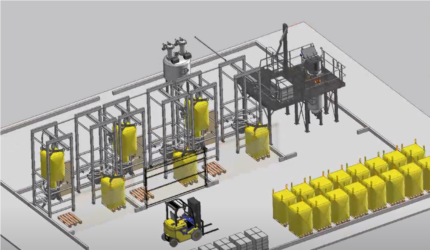Improved capacity and hygiene for a dairy/nutrition company
One of the most common processes within the dairy/nutrition business is a process step which involves powder addition into a liquid mixing step.
The powders are delivered either in the form of big bags or sacks, which are then added into to the liquid mixing process. Some of these powders require thorough cleaning of equipment between batches to ensure good product hygiene (risk of bacteria growth) and no contamination between recipes (flavors, lactose, probiotics etc).
Tekemas’ customer analysis and proposed solution both improved capacity and throughput, while also taking into account the hygienic needs to produce sensitive dairy/nutritional products.
The main solution to increase productivity in this process is to minimize WAITING time by adopting parallel processing. This waiting time typically occurs in the following process steps:
- 1. Charging of powders or refilling the powder source
- 2. Emptying the process
- 3. Cleaning of the system
Big bags and sacks are by far the most common packaging format for handling and transporting different powders and ingredients. In many cases, these packages have been transported on lorries and stored in warehouses before they are to be used within the production facilities. In many cases, it is the packaging itself that could present the biggest risk of hygiene “problems” for the manufactured product. To solve this, the process was designed so that these packages do not enter the sensitive areas within a production facility.
A breakdown of Tekemas’ process solution:
Improving capacity
- Double position discharge points for major raw ingredients, which allows changeover of raw ingredients without interference (waiting time) for the next process
- Batch hopper to minimize charging time of the liquid mixer
- Separate conveying lines into batch hopper making the charging work in parallel
Cleaning
- The system is designed for easy cleaning and disassembly (if needed) to minimize changeover time between recipes (either dry or wet)
- CIP solution is included in the batching hopper.
- Separate conveying lines for high-risk ingredients to eliminate the need of clean down (dedicated ingredient lines)
Minimizing cross-contamination risks
- The discharge points are within dedicated rooms to minimize area where dust can spread and also to keep the potentially contaminated packaging outside of sensitive production areas.
- Separate conveying lines for high-risk ingredients to eliminate the need of clean down (dedicated ingredient lines).
Result:
- Vast improvement of hygiene zones and elimination of risk of cross-contamination between ingredients due to allocated ingredient areas
- Cutting the average charging time of raw ingredients by 15min-20min per hour due to no waiting time for big bag changeovers, and also introducing more ingredients to be handled from big bags
- Cutting the clean down by 90 min. for every recipe changeover (eliminating cleaning)

